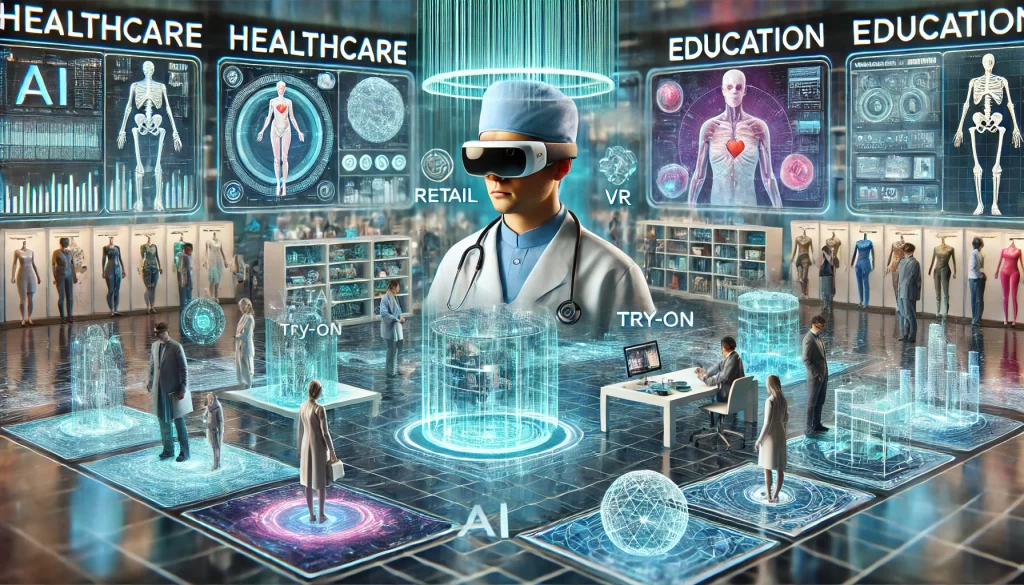The convergence of Artificial Intelligence (AI) with Augmented Reality (AR) and Virtual Reality (VR) displays is driving a new era of immersive experiences, significantly impacting industries from gaming to healthcare and beyond. As AI algorithms become increasingly sophisticated, they’re enabling AR and VR systems to become more intuitive and responsive to user inputs, environment, and context. This integration not only enhances visual fidelity but also allows for real-time data processing, facilitating applications such as realistic holograms, seamless object recognition, and predictive modeling within AR/VR environments.
Growing popularity of Metaverse, increasing demand for OLED displays in AR and VR devices, growing adoption of AR and VR HMDs in different industries, growing adoption of AR and VR devices in various applications, and adoption of AR and VR devices in gaming industry are key driving factors for the AR and VR display Market.

Key Advancements:
- Enhanced Image Rendering: AI-driven AR/VR displays employ deep learning algorithms for advanced image rendering, improving visual details by predicting and correcting distortions in real-time.
- Personalized User Experience: By analyzing user behaviors and preferences, AI can tailor AR/VR experiences, making virtual spaces more adaptive and personal.
- Real-Time Object Interaction: AI enables AR/VR displays to process user interactions with virtual objects instantly, bridging the gap between real-world physics and virtual feedback.
- Reduced Latency and Improved Synchronization: AI algorithms optimize data flow and processing speed, reducing latency and enhancing user comfort in immersive environments.
With continued advancements, the AI-enhanced AR and VR display market is poised to redefine how we engage with digital content, merging physical and digital worlds more seamlessly than ever before.
In addition to transforming user experiences, AI-enhanced AR and VR displays are also making significant strides in industrial and medical applications. For example, AI-driven displays in AR surgical systems allow healthcare providers to visualize patient data in real-time with remarkable accuracy. This real-time, augmented information helps reduce the margin of error in complex procedures and improves patient outcomes. Similarly, industries like aerospace and automotive are using AR and VR, backed by AI, to enhance design and simulation processes. By accurately overlaying models on physical parts, engineers can assess design modifications, improving efficiency and reducing time-to-market for new products.
The retail sector is also rapidly adopting AI-enabled AR/VR solutions. Retailers are using these advanced displays to offer virtual try-on options for clothing, furniture, and other goods, giving customers a personalized and interactive shopping experience. Through AI-powered computer vision, these displays can analyze body shape and size in real-time, providing a realistic preview of how products would look in real life. As AR and VR displays become more responsive and intuitive, they are likely to play a vital role in both online and in-store retail experiences, bridging the gap between digital and physical shopping environments.
Finally, in the realm of education and training, AI-infused AR/VR displays are reshaping the learning landscape. Educational institutions and professional training centers are using these displays to create immersive learning environments where students can interact with complex models, from molecular structures to historical sites, in 3D. This form of active learning, facilitated by AI, allows learners to explore subjects in greater depth, increasing comprehension and retention. As AI continues to evolve, these displays will play an increasingly central role in making education more accessible, immersive, and effective across diverse fields.
In addition to transforming user experiences, AI-enhanced AR and VR displays are also making significant strides in industrial and medical applications. For example, AI-driven displays in AR surgical systems allow healthcare providers to visualize patient data in real-time with remarkable accuracy. This real-time, augmented information helps reduce the margin of error in complex procedures and improves patient outcomes. Similarly, industries like aerospace and automotive are using AR and VR, backed by AI, to enhance design and simulation processes. By accurately overlaying models on physical parts, engineers can assess design modifications, improving efficiency and reducing time-to-market for new products.
The retail sector is also rapidly adopting AI-enabled AR/VR solutions. Retailers are using these advanced displays to offer virtual try-on options for clothing, furniture, and other goods, giving customers a personalized and interactive shopping experience. Through AI-powered computer vision, these displays can analyze body shape and size in real-time, providing a realistic preview of how products would look in real life. As AR and VR displays become more responsive and intuitive, they are likely to play a vital role in both online and in-store retail experiences, bridging the gap between digital and physical shopping environments.
Finally, in the realm of education and training, AI-infused AR/VR displays are reshaping the learning landscape. Educational institutions and professional training centers are using these displays to create immersive learning environments where students can interact with complex models, from molecular structures to historical sites, in 3D. This form of active learning, facilitated by AI, allows learners to explore subjects in greater depth, increasing comprehension and retention. As AI continues to evolve, these displays will play an increasingly central role in making education more accessible, immersive, and effective across diverse fields.
